Emailing
Branding & email marketing: Cómo compartir los valores de tu marca por email

Emailing

Estamos en 2019 y el mundo del marketing parece estar en medio de una revolución conceptual. Hay tantos términos nuevos que aprender, tecnología innovadora que usar e ideas creativas que probar que las marcas apenas tienen tiempo de pararse a pensar qué es lo que significa en realidad “hacer marketing” a día de hoy.
La buena noticia es que los conceptos básicos siguen siendo los mismos: el marketing sirve para crear y promocionar el valor de algo e intenta buscar distintas formas de conectar con una audiencia para comunicar qué es lo que hace que el producto o el servicio sea único e indispensable.
Pero en el mundo en el que vivimos, el valor no solo se define por las cualidades prácticas del producto. Qué es una marca y por qué destaca es ahora tan importante como lo que puede hacer un producto. Ahora que las audiencias sintonizan más que nunca con el entorno, no solo se recomienda entrar en la conversación, sino que es algo que se espera. Comunicar los valores éticos de la marca es una parte integral de cualquier estrategia de marketing.
El espacio del marketing está tan abarrotado y es tan competitivo que la principal prioridad de las empresas es conseguir fidelizar a los consumidores, y mostrar el lado más humano de tu marca es fundamental para lograrlo.
Tal como advierte Colin Lewis, “la transformación de la economía y el panorama cultural supone que a los expertos en marketing nos espera un futuro muy diferente. Tenemos que entender que, como resultado, la misma noción de valor está cambiando”.
Antes, el precio y la oferta podían bastar para que los clientes repitieran. Pero ahora, una base de consumidores más consciente se traduce en que las empresas tienen que trabajar duro para ser diferentes y marcar la diferencia. Crear un vínculo emocional entre la marca y sus clientes es fundamental para reforzar la relación.
Como ya mencionamos cuando hablamos sobre las tendencias del marketing por email que jugarían papeles importantes durante el 2019, influir de forma positiva y contar la historia de la marca de manera eficaz es una manera de conectar con los clientes porque ahora recelan más y se mueven menos por la venta agresiva, y son mucho más receptivos al storytelling de marca y sus valores.
El storytelling consiste básicamente en vender historias. Para diferenciarse de la competencia, las marcas tienen que mostrar su personalidad y dejar claro cuáles son sus valores, y el email es el mejor canal para hacerlo.
Según The Drum, el 80 % de los clientes desea que las marcas le cuenten su historia, pero no puede recordar un buen ejemplo. Bien contadas, las historias calan en los clientes a largo plazo, pues se sienten identificados con la personalidad y objetivos de la marca y empezarán a sentirse emocionalmente implicados en su éxito.
Contar una historia de marca que la gente recuerde y con la que conecte no es precisamente fácil, así que vamos a darte algunos consejos con los que puedes empezar el proceso.
Es al principio de entablar una relación con un cliente cuando las marcas deben poner los cimientos para crear esa conexión emocional. Los emails de bienvenida pueden ser un recurso fabuloso para sentar las bases y presentar la misión.
Por ejemplo, el minorista de calzado TOMS busca posicionarse como un “movimiento” y una “familia”, no como una corporación sin rostro. Cuando los usuarios se registran, pueden personalizar su relación con la marca eligiendo las historias que más les interesan.
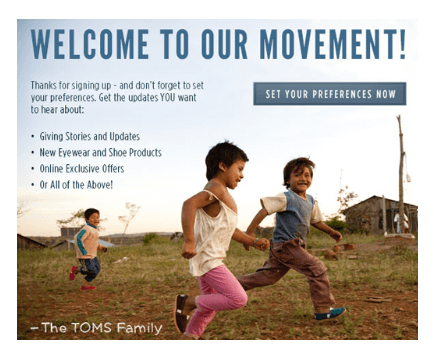
Cada historia necesita su héroe. Da lo mismo que sea la marca o el cliente quien asuma ese papel: compartir la repercusión que otros tienen en el mundo y celebrar hitos (tanto de la marca como del cliente) es una manera estupenda de conectar con tu audiencia.
Por ejemplo, una de las tácticas preferidas de American Express es mostrar historias de clientes que han usado sus recompensas para triunfar y de emprendedores que están marcando la diferencia; un planteamiento diferente con respecto a las campañas testimoniales tradicionales.
Todos sabemos detectar una sonrisa falsa. Por eso, los expertos en marketing deben evitar usar imágenes de stock cuando estén en pleno proceso de entablar una relación de confianza con los suscriptores. Es mucho mejor que den la bienvenida al usuario o celebren el éxito de la marca con fotos de clientes que cuenten la historia de forma honesta.
Echa un vistazo a la campaña deUber. Al poner el foco en el heroísmo del conductor, no en la empresa, Uber duplica su atractivo emocional y demuestra que celebran el éxito de forma inclusiva.
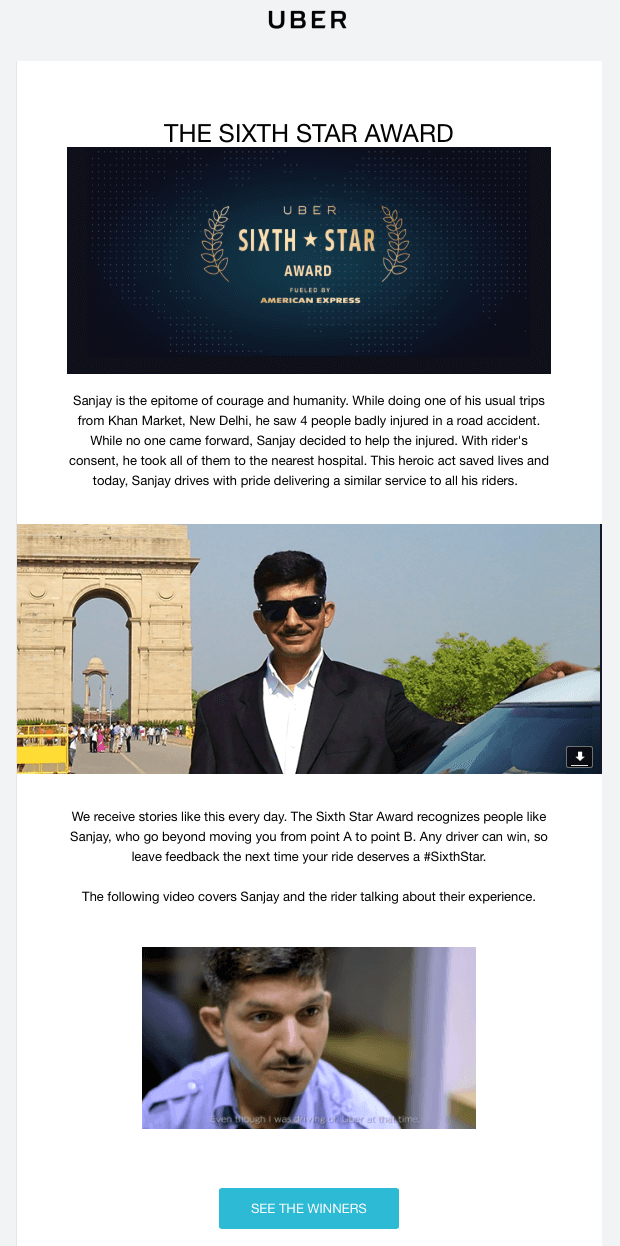
En un pasado muy lejano, las historias se transmitían de boca a boca. Ahora hay muchísimos modos de compartir los valores de marca: el email es uno de ellos, pero algo tan importante como los valores éticos de la marca no debe quedarse solo en la bandeja de entrada.
Un buen enfoque es mejorar la estrategia de comunicación multicanal y compartir la historia con clientes a través de distintos puntos de contacto, incluyendo el sitio web, los perfiles de redes sociales, el email, medios físicos, etc.
Centrarse en lo que más apasiona a la empresa y lo que esta defiende es el primer paso del desarrollo de marca. Para muchos, se trata de proteger el medio ambiente o de crear una sociedad más inclusiva y diversa. Otros se centran en promover la investigación y el desarrollo para continuar innovando en sus campos. La mayoría quieren que sus clientes sepan cómo protegen su información personal y hacen de Internet un lugar seguro para todos.
Definir esos valores fundamentales de la historia de una marca es el comienzo y compartirlos es el siguiente paso lógico. Si bien el email nunca debe ser el único canal para comunicar de qué va tu empresa, sí que es el pilar del storytelling de los valores éticos de la marca.
A continuación incluimos ocho ejemplos de cómo algunas de las compañías más importantes del mundo comparten sus objetivos de sostenibilidad, innovación y cumplimiento de datos.
La crisis climática es un problema que define esta era y el estado de la Tierra preocupa tanto a las personas como a las empresas. Cuando hables de los valores éticos de la marca, asegúrate de que el desarrollo empresarial va unido a la protección del medio ambiente. Se ha convertido en uno de los valores de marca más apreciados por los clientes y cada vez son más las marcas que estudian integrar este problema entre sus principales iniciativas de >branding.
En la industria minorista, hay distintas marcas que han tomado medidas después de que Greenpeace presionara para detener el uso de productos químicos peligrosos en la cadena de suministro de ropa y muchos están dejando de usar recibos de papel. Para Galerías Lafayette, líder del sector en Francia, la ecología fue un elemento decisivo para dejar de dar recibos físicos a los clientes, acción con la que reducían la cantidad de papel y abordaban una preocupación medioambiental.
A continuación damos dos ejemplos de cómo las marcas dan a conocer su lado eco-guerrero y cuentan su historia de sostenibilidad por email.

Lush dedica todo un email a hablar sobre qué les hace diferentes. Su potente texto (“Nuestros valores están en nuestros productos”) deja claro que la sostenibilidad no consiste solo en tachar un elemento de una lista, sino que es algo que se toman muy en serio. Los fantásticos elementos visuales destacan tanto el producto como la cadena de producción y refuerzan el hecho de que el valor no solo está en el producto, sino integrado en toda la marca.

En el caso del proveedor energético Bulb, la sostenibilidad es el corazón del negocio. La energía limpia es uno de sus lemas y compartir los logros de sus usuarios y de la empresa es fundamental para fidelizar a los clientes.
Este email de resumen convierte los números en historias (con elementos visuales atractivos que hacen que esas cifras sean aún más interesantes) y anima al lector a compartirlos en Twitter, integrando fácilmente estos dos potentes canales para llegar a una audiencia nueva.
Cada vez más, las empresas adoptan la diversidad y la inclusión en el espacio de trabajo como un modo de recordar al mundo que los dos tienen relación con la rentabilidad de una empresa, pero defender ambas cosas va más allá de eso.
Poner en marcha acciones más amplias que puedan servir de ejemplo e inspirar a otros en todo el mundo puede marcar una diferencia positiva a nivel global. Compartir la historia por email puede demostrar a los clientes qué es lo que hace que la marca destaque y qué va a hacer para cambiar las cosas.
Estas son nuestras conclusiones de los buenísimos ejemplos de Leesa y TOMS.

Si hay algo mejor que solucionar un problema uno mismo es saber que otros han ayudado durante el proceso. Este es el mensaje principal del email de Leesa. Un colchón no es un lujo: es algo que todos necesitamos, y cuando un cliente compra uno a Leesa ayuda a los más desfavorecidos y está apoyando a una empresa que trabaja para hacer del mundo un lugar más inclusivo.
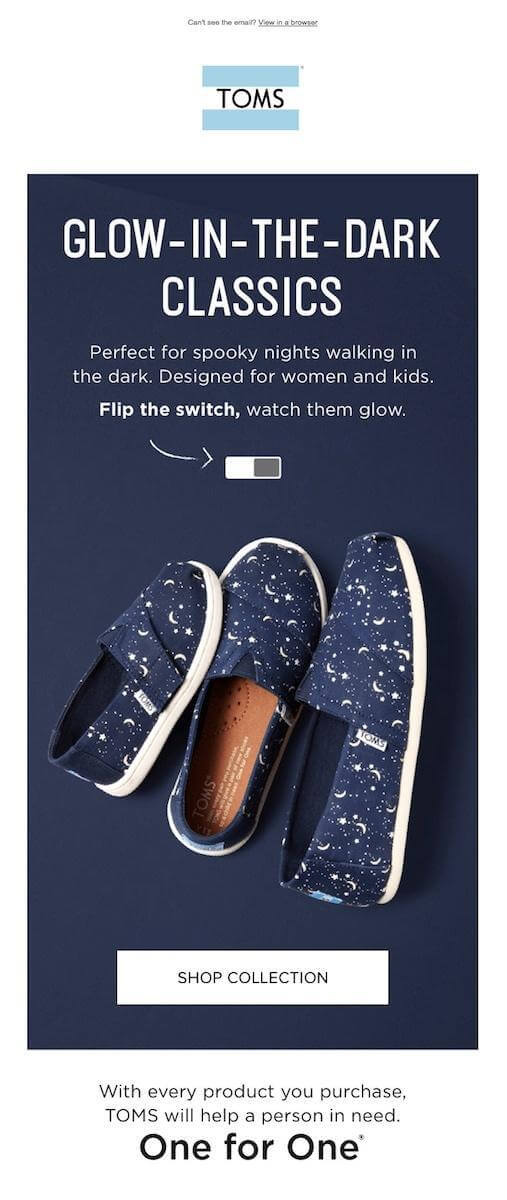
En el caso de TOMS, una parte importante de su estrategia es comunicar sus valores de marca. Además de hacerlo en todos sus emails, han creado el lema One for One (Uno por uno) como un punto clave de su mensaje en todas sus comunicaciones de marca. No es algo puntual, es tan importante como el producto en sí.
Para algunas empresas, especialmente para las tecnológicas, la investigación y el desarrollo es un elemento crucial en su estrategia empresarial. Encabezar el progreso dentro de la industria promoviendo la I+D y desafiando el statu quo es fundamental en el desarrollo del producto y en su cultura interna.
Esto no es exclusivo de la tecnología y muchas marcan consideran que este es un valor que comparten con su audiencia objetivo. A continuación te contamos cómo las empresas de ropa para actividades al aire libre Oros y Patagonia comparten su afán de innovación constante.

En el caso de Oros, la idea de la innovación y de sobrepasar los límites está presente en todos los niveles. Es algo obvio tanto en este email como en su lema, “Find your beyond” (Descubre tus límites). En este email de bienvenida, Oros conecta con su audiencia centrándose en algo fundamental para la empresa y sus clientes: reinventar las fronteras, innovar y seguir avanzando.

Patagonia hace algo parecido y también se centra en la I+D y en superar las barreras. Lo que hace que este email sea especial no son solo los valores que comparte la empresa, sino cómo los comparte.
Muchas marcas explican cómo su preocupación principal sigue siendo la de mejorar sus productos lo máximo posible o añadir los últimos avances tecnológicos a sus servicios. Lo que pasa es que hay una diferencia entre tener algo que decir y tener algo que pueda demostrar lo que dices. Patagonia usa citas y premios para aportar pruebas sociales y hacer saber a la gente que no se quedan en las palabras.
Un año después del RGPD, y como resultado de la controversia generada por determinados casos sobre protección de datos en todo el mundo (incluyendo el escándalo de Facebook con Cambridge Analytica), el cumplimiento de datos se ha convertido en una gran preocupación para muchos clientes.
De hecho, en un estudio reciente hecho por Mailjet, el 39 % de los clientes encuestados pedían un endurecimiento de las penas para las marcas que incumplieran los reglamentos de privacidad de datos, especialmente para las más grandes, a las que el 27 % de los consumidores considera indemnes frente al RGPD.
Demostrar lo mucho que tu empresa valora la privacidad de datos e ir más allá en lo que a proteger los derechos de datos de tus usuarios se refiere es la mejor manera de ganarte la confianza de tus clientes.
Ahora vamos a ver cómo lo hacen Slack y Hostelworld.
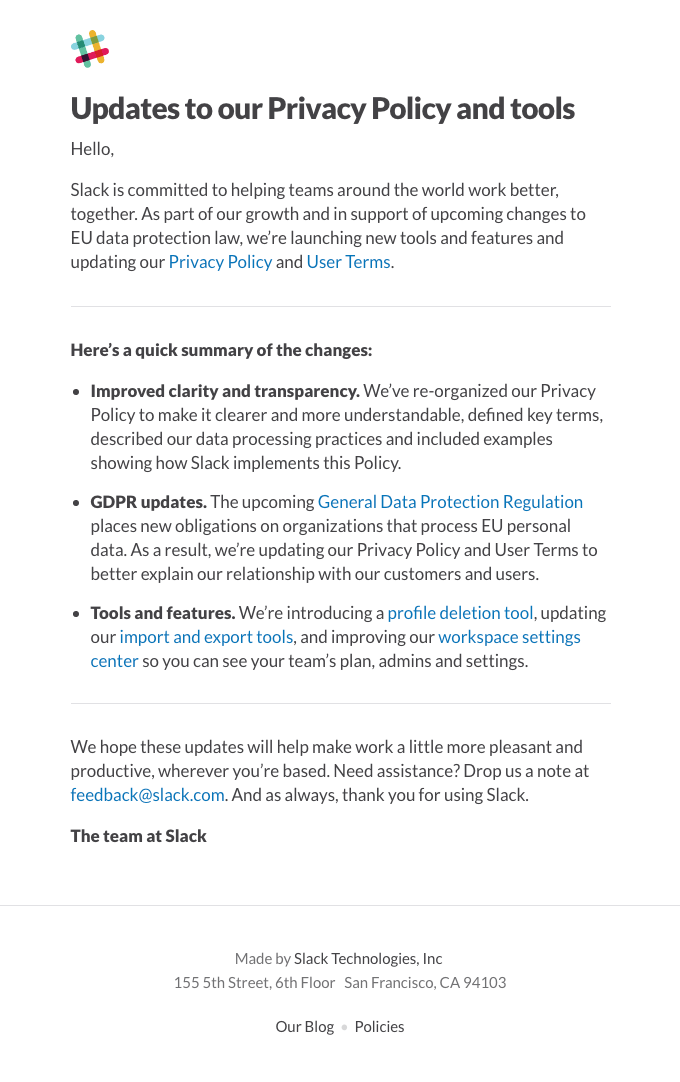
Cuando el RGPD entró en vigor hace un año, muchas empresas enviaron emails para informar a sus usuarios de los cambios en las políticas de protección de datos. No obstante, por la forma de comunicar los cambios (la mayoría solo incluyó enlaces a documentos completos), daba la impresión de que solo querían cumplir con una obligación impuesta, más que querer ser honestas con los clientes.
El email de Slack lo hace genial: destaca las conclusiones principales y hace que el lector sienta realmente que les preocupa la claridad y la transparencia. Es fácil de leer, va directo al grano y es claro.
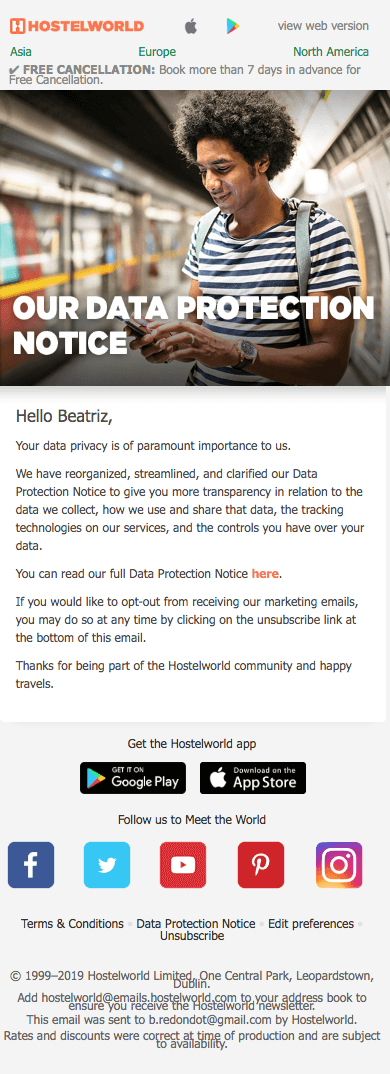
Hostelworld redactó una notificación de protección de datos muy clara para demostrar lo importante que es para la empresa. Pero la cuestión no radica solo en la claridad: también se trata de decirle a la gente que puede confiar su información personal a Hostelworld. Por eso usan el email para comunicarlo y para reforzar la idea de que Hostelworld es una empresa en la que pueden confiar.
Los valores éticos de marca están convirtiéndose poco a poco en una de las capas más importantes para crear el valor de un producto. Humanizar una marca va más allá de buscar los valores que definirán el papel de una empresa en la sociedad. Elaborarlos es un paso necesario, pero compartirlos es lo que fidelizará a los consumidores a un producto o servicio en concreto.
Los estrategas de las marcas, además de tener que diseñar la historia de la empresa, tendrán que elegir los canales adecuados para comunicarla a una audiencia. De todos los canales de marketing disponibles, el email ofrece las mejores oportunidades para conectar con los suscriptores a lo largo del ciclo de vida del consumidor.
En un mundo en el que el valor no solo lo definen las cualidades de un producto, sino también los valores éticos de la marca, aplicar técnicas de storytelling para compartir los valores se ha convertido en algo que no puede faltar en el marketing de marca.